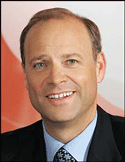 |
| Sanofi CEO Chris Viehbacher |
No buyer's remorse for Sanofi ($SNY) CEO Chris Viehbacher. Acquiring Genzyme for $20.1 billion in 2011 has paid off handsomely, Viehbacher told the Boston Globe in an interview--and not only in terms of drug sales and new regulatory approvals.
True, Genzyme came with some pricey, successful rare-disease drugs, including the Fabry disease treatment Fabrazyme and the Gaucher disease therapy Cerezyme. Genzyme's products have been growing ever since the buyout, adding a measure of brightness to Sanofi's dim pharma sales picture. For the first half of 2013, Genzyme products delivered a bit more than €1 billion (about $1.35 billion), a 22% increase year-over-year. Overall, net sales were down almost 10% for the second quarter.
As for the pipeline products Genzyme brought along, three have won regulatory approval in recent months: the multiple sclerosis pill Aubagio, approved by the FDA in October 2012; Kynamro, a treatment for homozygous familial hypercholesterolemia, FDA-approved in January; and Lemtrada, cleared for sale in Europe earlier this week, but still awaiting an FDA nod.
What Viehbacher highlights in his Globe interview is something a bit more slippery. "Once we had Genzyme, that changed investor perception about Sanofi," Viehbacher told the newspaper. "It significantly increased the visibility of Sanofi in the United States. It signaled that Sanofi was a company that was serious about biotechnology and research and development."
Viehbacher attached some numbers to that shift in perception; Sanofi's share price has grown by more than 50% since the buyout. The Globe calculates a $40 billion increase in market value.
What may be most important in the long run, for Sanofi's shares and bottom line, may be another shift. As Viehbacher's confidence in Genzyme's research prowess has grown, the center of gravity in Sanofi's R&D operations has moved to Cambridge, MA, from France. The company has been laying off French workers and consolidating R&D there, while building up in Cambridge.
Indeed, Viehbacher's remarks came as he was preparing to cut the ribbon today on a new cancer research hub. And, he noted, the company is allying itself with smaller biotechs in the area to further improve its R&D prospects, so its U.S. presence goes beyond its own walls. "When you look at a company's ecosystem," he told the Globe. "I'm not sure you can measure it just in square feet and head count."
- read the Globe story
Special Reports: The 20 Highest-Paid Biopharma CEOs - Christopher Viehbacher | Top 10 Pharma Companies by 2012 Revenues - Sanofi